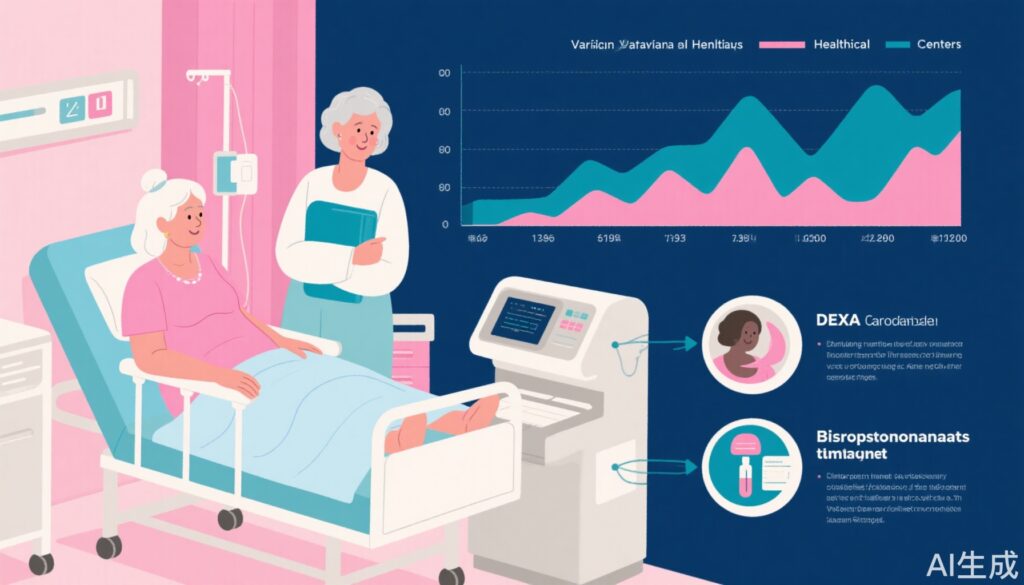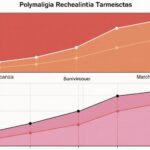Highlights
- Bone health management in older women (≥70) with early breast cancer (EBC) receiving aromatase inhibitors (AIs) shows considerable variation across UK centres.
- Only 67% of AI-treated patients received a baseline DEXA scan, and 43% were prescribed bisphosphonates.
- Fracture rates remain high (23%), with only 38% of those with fractures having received prior bisphosphonate therapy.
- Decisions on bone health interventions were influenced by age and surgical fitness, not frailty status or T-scores, underscoring gaps in guideline adherence.
Clinical Background and Disease Burden
Osteoporosis is prevalent among older women, affecting up to half of those aged 80 and above. The use of aromatase inhibitors (AIs) for hormone receptor-positive early breast cancer (EBC) exacerbates bone loss, significantly increasing fracture risk. Given the high survival rates in EBC, long-term adverse effects such as osteoporosis and fractures substantially impact quality of life and morbidity. Guidelines recommend bone density monitoring and preventive therapy, but real-world adherence, especially in the elderly, remains unclear.
Research Methodology
This sub-study analyzed data from the Age Gap study, a multicentre UK observational cohort (2013–2018) investigating care variation in women ≥70 years with EBC. The present analysis included 565 women with estrogen receptor-positive (ER+) tumors from five hospitals, all of whom received adjuvant or primary endocrine therapy (AIs or tamoxifen). Detailed data on bone health assessment (baseline DEXA scan), bisphosphonate prescriptions, and outcomes (fractures) were collected. Frailty was measured using the Rockwood scale.
Key Findings
Among 565 ER+ patients, 529 (93.6%) received AIs and 26 (4.6%) tamoxifen. The median age was 77 (range 70–98). Baseline DEXA scans were performed in 67% (354/529) of those on AIs, but rates ranged from 36% to 76% between centres. Of those scanned, 42% (148/354) were osteopenic and 18% (64/354) osteoporotic. Bisphosphonate therapy was prescribed to only 43% (226/529) of AI-treated patients, more often to those under 80 (p = 0.02) and those fit for surgery. Over a median follow-up extending to 2022, 23% (122/529) experienced fractures, but only 38% of these had received bisphosphonate therapy beforehand.
Frailty (Rockwood) was present in 94% (431/461) of patients, but showed no correlation with DEXA T-scores for hip or spine (r2 < 0.01). Notably, clinical decision-making around bone health interventions appeared influenced by age and surgical fitness rather than objective bone density or frailty status.
Mechanistic Insights and Biological Plausibility
AIs suppress estrogen synthesis, leading to accelerated bone turnover and loss of bone mineral density. Older age compounds this risk due to cumulative physiologic bone loss, and comorbidities may further increase fracture susceptibility. Bisphosphonates and DEXA-guided management are evidence-based interventions to mitigate this risk (Hadji et al., Ann Oncol. 2017).
Expert Commentary
Current international guidelines advocate routine DEXA scanning and consideration of bone-modifying agents for postmenopausal women starting on AIs (ESMO, NCCN). However, this study’s findings align with previous reports indicating suboptimal real-world implementation, particularly in the oldest and frailest cohorts (Gralow et al., J Clin Oncol. 2013).
Controversies and Limitations
Significant inter-centre variation (36–76% DEXA use) and age-based treatment disparities suggest systemic barriers to standardized care. The reasons for these discrepancies remain unclear and may include provider knowledge gaps, resource limitations, or implicit ageism. The observational design limits causal inference, and unmeasured confounders may have influenced both treatment decisions and outcomes. Generalizability beyond the UK setting remains uncertain.
Case Vignette
Mrs. Helen Smith, a 79-year-old with newly diagnosed ER+ EBC, is started on letrozole. Her oncology team omits a baseline DEXA scan due to her advanced age and perceived frailty. Two years later, she sustains a vertebral fracture, with subsequent testing revealing osteoporosis. Her case exemplifies the consequences of inconsistent bone health monitoring and the need for standardized protocols, regardless of age.
Conclusion
Despite the recognized risk of osteoporosis and fractures in older women with EBC on AIs, bone health management remains inconsistent, with substantial variation across UK centres. Age and surgical fitness, rather than objective risk or frailty assessment, predominantly guide clinical decisions. These findings underscore the urgent need for standardized, guideline-concordant bone health protocols to optimize outcomes in this vulnerable population.
References
1. Theodoulou E, Martin C, Morgan J, et al; Age Gap Trial Steering Group. Variation in bone health management in older women with breast cancer: A secondary analysis of the Age Gap study. J Geriatr Oncol. 2025 Jul 17;16(7):102315. doi: 10.1016/j.jgo.2025.102315. Epub ahead of print. PMID: 40680689.
2. Hadji P, et al. Management of Aromatase Inhibitor-Associated Bone Loss. Ann Oncol. 2017;28(9):2206–2212.
3. Gralow JR, et al. Bone health in breast cancer survivors: A guideline update. J Clin Oncol. 2013;31(12):1461-1467.
4. European Society for Medical Oncology (ESMO) Clinical Practice Guidelines: Early breast cancer. Ann Oncol. 2021.



